How To Care For Pet Sugar Glider
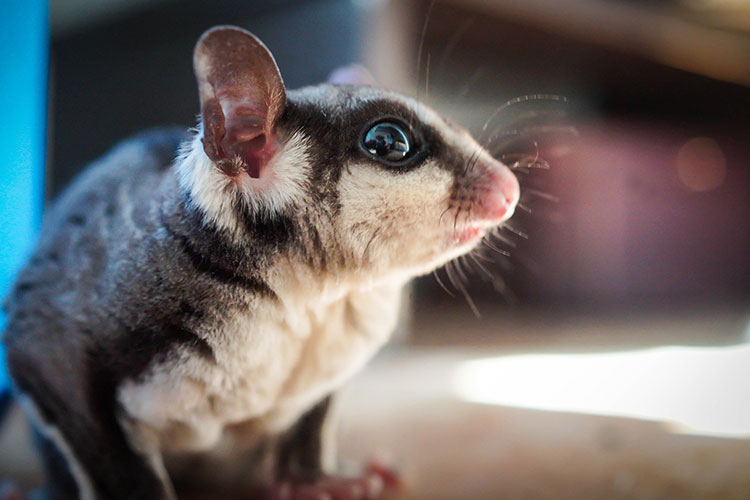
While sugar gliders make adorable, unusual, and fascinating pets, there are several things you should know before getting one.
As soon as you bring your sugar glider home, you will need to spend time each day maintaining the sugar glider’s habitat and socialising it. Keeping sugar gliders requires cleaning their cages at least once a week, as well as preparing their food, changing bedding and cleaning up after them. It’s also important for you to spend time every day with your sugar glider if you don’t have a second sugar glider for it to socialise with as a pair.
Sugar gliders do not adapt well in households with other pets, such as dogs or cats, so if you decide you want to have a sugar glider as a pet, you must accept the sugar glider’s need to be the only pet in your house.
Taking Care of Pet Sugar Glider
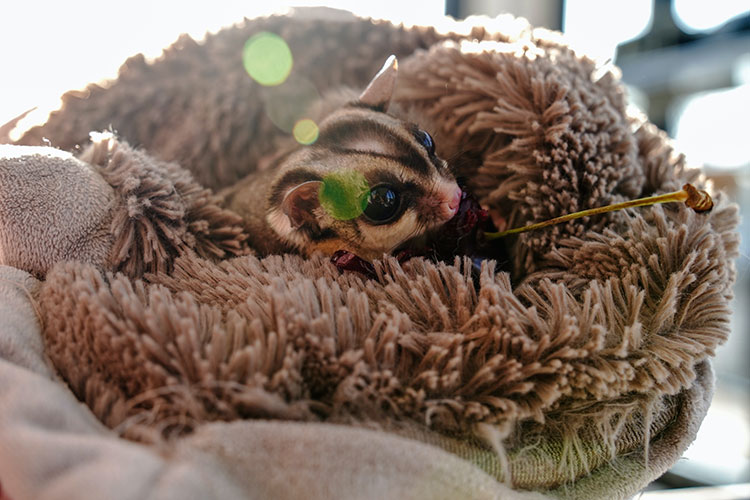
Spending time with your sugar glider on a daily basis will help you understand what it likes and dislikes. Your knowledge of how to clean and maintain your sugar glider’s cage will also improve. In order to maintain a comfortable habitat for your little furry companion, you will need to restock their everyday supplies and accessories.
Listed below are the following supplies your sugar glider needs on a regular basis:
- Pouches
- Nest boxes
- Bedding
- Cage liners
- Sugar glider food
- Sugar glider treats
- Sugar glider toys
- Vitamins
- Pet odour and stain remover
- Cleaning supplies
Sugar Glider Care and Exercise
Sugar gliders require veterinary care, cage cleaning, grooming, and exercise just like any other pet. Maintaining a clean environment for sugar gliders is also very important.
Sugar Glider Exercise
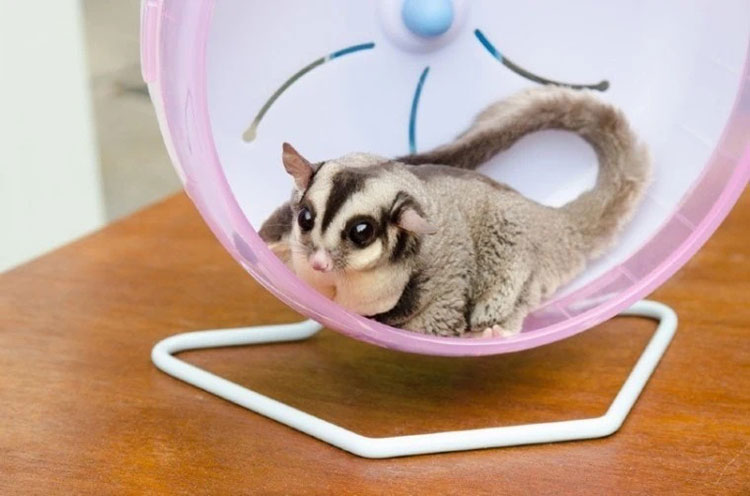
Sugar gliders need plenty of stimulation while living in their cage to stay active, engaged, healthy, and happy. Pet stores offer many toys, branches, perches, ropes, ladders, plants, bridges, tunnels, and hoops that can be used for this purpose, but you should also provide your sugar glider with its own exercise wheel. The exercise wheels are like hamster wheels, except that they do not have a center axle. They are also quieter and larger, so they are a better fit for sugar gliders. It is highly recommended that you purchase an exercise wheel for your sugar glider and also get wheel sandpaper to file its nails as it runs.
Sugar Glider Cage Cleaning
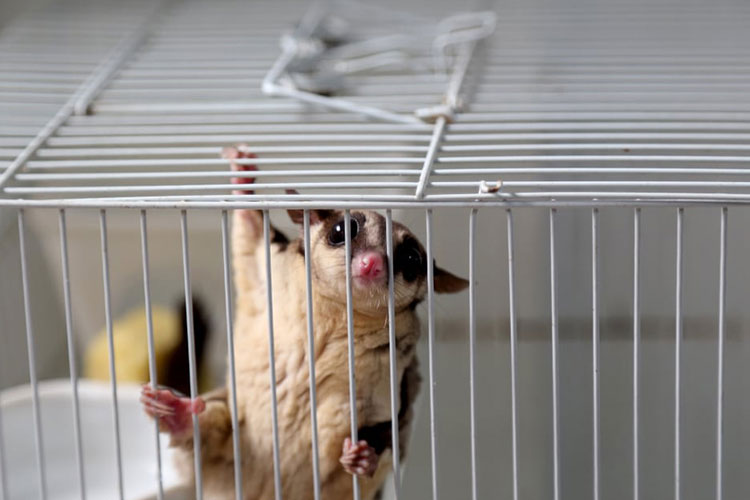
Removing food waste, washing food containers, and replenishment of the food containers with fresh food are all part of the sugar glider cage cleaning daily routine. It’s important to make sure your sugar glider has access to clean water at all times. Cage trays should be cleared of debris each day and cage liners should be changed at least twice every week.
Aside from performing minor checks and cleaning on a daily basis, you need to perform a deep cleaning of your sugar glider’s cage once every two weeks. All cage surfaces should be thoroughly sponged with hot water and a solution of vinegar or dish soap to remove fluids, waste, and debris. Make sure you wash and dry your sugar glider’s sleeping pouches, cloth toys, and other fabric items at least once a week. Do not use fabric softener on these items, and if they are heavily soiled or torn, you should replace them.
Unlike cats and dogs, a sugar glider cannot be toilet trained. It is common for sugar gliders to urinate and defecate on their owners, but you’ll soon find out that most of this occurs after they wake up. By allowing your sugar glider to use the bathroom after waking, you are less likely to be affected by these “accidents”.
Sugar Glider Grooming
You must ensure your sugar glider’s nails are properly clipped as part of your pet care responsibilities. The long nails of a sugar glider can put you and your family at risk for injury, as their nails are capable of cutting into the skin and causing an infection. Even if your sugar glider is in the safety of its own cage, its nails can still catch onto fabric or other materials, resulting in the possibility of self-injury since it knows only how to pull away when trapped, causing severe harm to itself.
Sugar gliders are hypoallergenic pets and they don’t not attract mites or lice because of their thick fur. You don’t need to give sugar glider a bath as they take care of their fur on their own. Giving your pet sugar glider a bath can be a stressful experience for them. Apart from not causing allergies, sugar gliders are extremely low-maintenance and easy to care for.
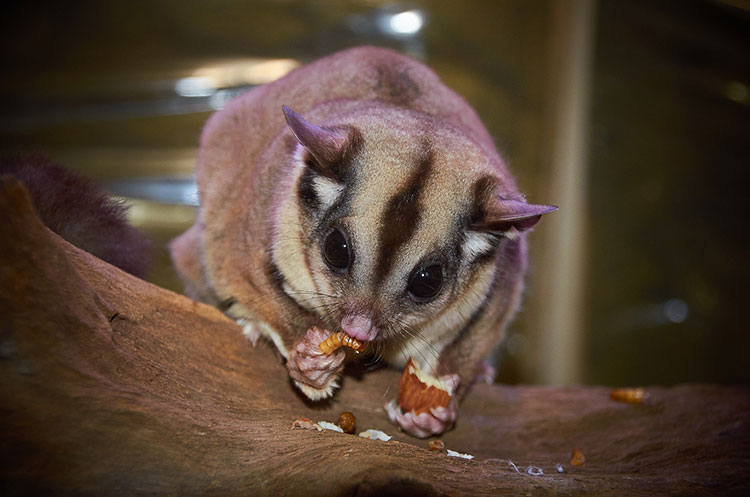
If you want to keep the teeth of your sugar glider clean, provide it with live mealworms or crickets as a daily snack. The tough exterior of the insects acts as a “brush” against the sugar glider’s teeth which removes tartar. Never cut, scale, or file your sugar glider’s teeth. They will experience immense pain and their teeth will also be permanently damaged.
Sugar Glider Veterinary Care
A sugar glider requires different care than dogs or cats, so you’ll need to find a veterinary clinic that has experience with exotic animals.
Feeding Your Sugar Glider
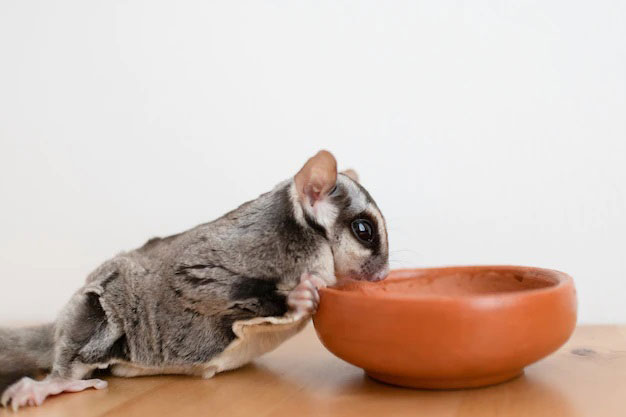
Ensure that you wash and dry your sugar glider’s food containers every day, and that their cage is always stocked with clean, fresh water. Sugar gliders are nocturnal animals and they mostly feed at night since they sleep during the day.
Place a shoebox at the bottom of your sugar glider’s habitat to make cleaning their cage easier. By placing your sugar glider’s food bowls in the box, the mess will be contained, rather than strewn about the cage floor while your sugar glider enjoys its meal.
Sugar Glider Lifespan
The amount of time that your sugar glider lives depends greatly on the level of care that you provide it. You can expect the lifespan of your marsupial to be between 10 and 12 years if you feed it a nutritious diet, provide it access to regular exercise, and keep it healthy. However, by the age of 5 to 7 years, your sugar glider is considered elderly and will begin to show signs of ageing.
Sugar Glider Common Health Issues
Your sugar glider has to be regularly examined and checked by an exotic animal veterinarian, or anytime it shows symptoms of being ill. There are several signs that indicate illness in these little marsupials, including poor appetite, lethargy, nasal discharge, laboured breathing, sneezing, eye discharge, itching, or lumps on the body.
Low blood sugar is common in sugar gliders when they stop eating because of illness. You should take your sugar glider to the vet immediately if you notice any of these symptoms: weakness, refusal to eat, tremors, or seizures. Low calcium levels can also be a problem for sugar gliders. Sugar gliders also occasionally hurt themselves when under stress; these behaviours may be triggered by being isolated, neglected, or experiencing discomfort.
Download the JoJo Pets app today for exclusive news and offers at https://jojo-pets.com/
